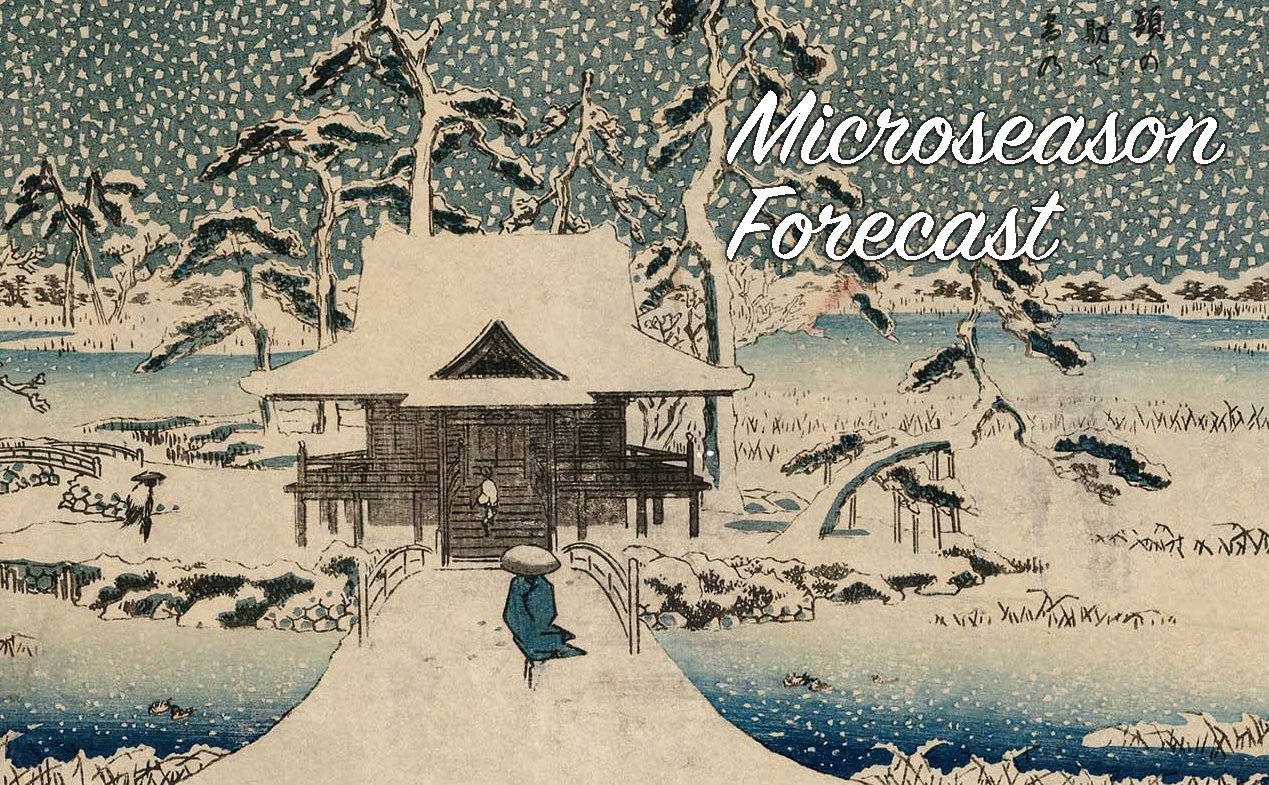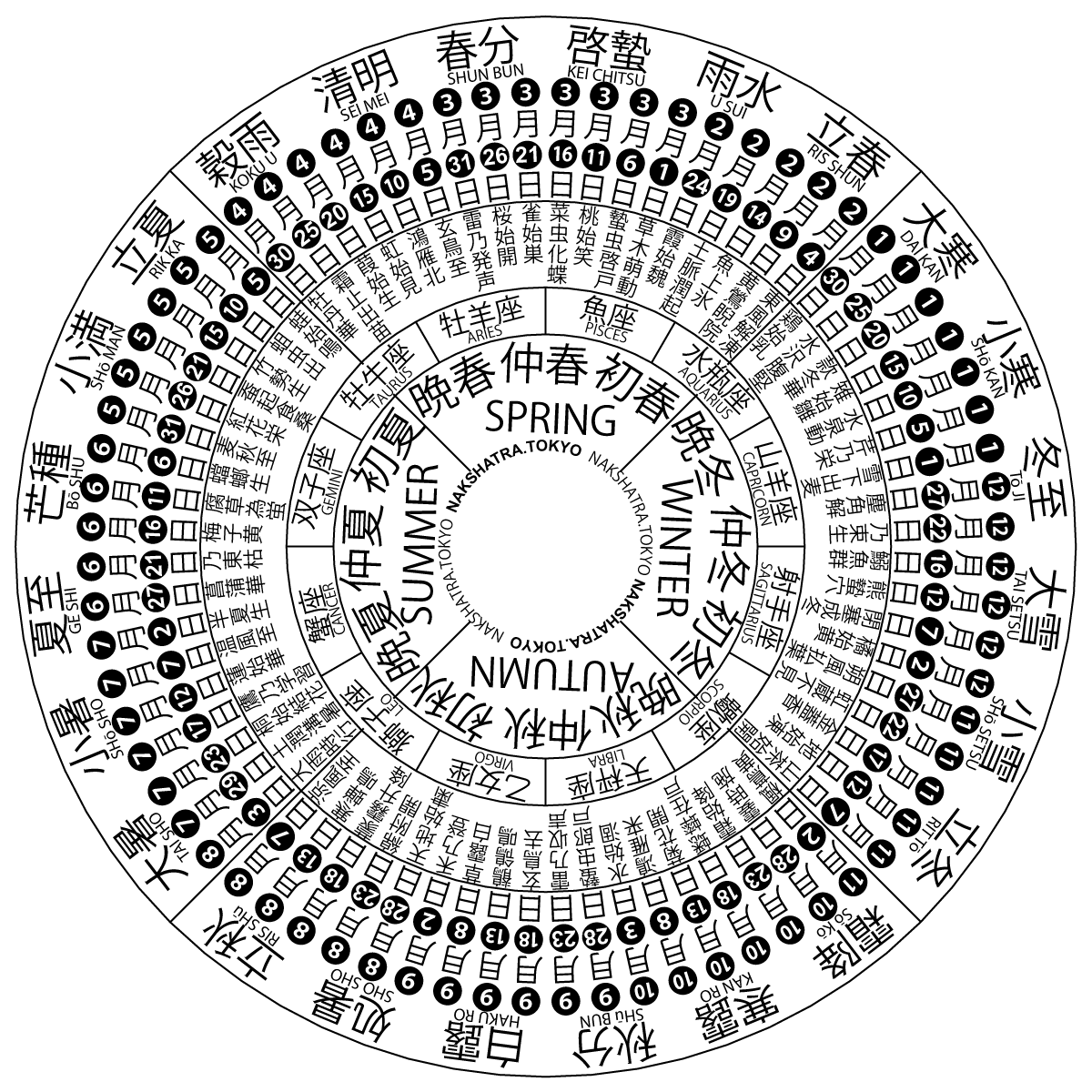Microseason Forecast for Jan 10 - Jan 14 ~ Notes from the Japanese Almanac

Today begins a new microseason! If this is your first time joining us, scroll down past the forecast to read about what exactly a microseason is. For the rest of you, let’s jump in!
The Current Solar Term: Shōkan
The current Solar Term is Shōkan (小寒), the 23rd solar term (節気, sekki), which means Small Cold.
Shōkan started Jan 5th and lasts until Jan 20th. We talked about this last time, so go here if you’d like to read more.
The Current Microseason: Frozen Spring Water Starts to Thaw
Two days ago (yeah, I’m behind), Jan 10th, began 水泉動, the 68th microseason (候, kō) which is read shimizu atataka o fukumu and means Frozen Spring Water Starts to Thaw. This is the second microseason of Shōkan, which is itself the fifth solar term of winter.
This is when the frozen springs in the land are starting to warm up, thaw, and move slightly. This is the coldest time of the year, but the days are getting longer and the sun is gradually warming up the earth as spring approaches.

Seasonal Fish: Shijimi Clams
Although these can be caught and eaten all year, it is said that they are especially good in winter. The are suppose to be good for the liver and help with hangovers, making them very useful for this post-New Years time.
They are quite good in miso soup. In the Edo era, kids would catch them in the morning and sell them to housewives, making a little pocket money.

Seasonal Activity
Jan 11 is Kagami Biraki (鏡開き), which refers to the breaking of the New Year’s mochi cake. This perhaps requires an explanation. For New Years, sticky rice is pounded and baked into large mochi cakes called kagami mochi consisting of two layers with an orange put on top. It can get much more decorated, but that is the basic design. This is a New Years decoration and is an offering to the gods, usually placed in the household Shinto alter (the kamidana). Anyway, on Jan 11th then, the cakes are broken open and eaten. By this time the mochi has often started to crack anyway. It is good luck to use a mallet (or ones fist) to hammer them open. The mochi is then often used in ozōni (お雑煮), a mochi soup, or ochiruko (お汁粉), a red-bean soup. Both are very good!
(Hive’s Japanese cooking expert @koto-art has given us recepies for both oshiruko and ozōni)

Here is a haiku for this microseason:
gasshō o shite ofukucha o itadakinu
I accept gratefully
lucky tea
—Miyamoto Shizuyo
On New Years, traditionally before even the first food of the year was eaten, the first scoop of water would be used to make Ofukucha, a lucky tea made with tea leaves, ume (pickled plums), kumbu seaweed, and sometimes pepper. After it was prepared it might last the entire first month (or beyond). It was drank with a prayer and a wish for health for the entire family for the year.
Ofukucha is a kigo (season word) for New Years, which traditionally was the beginning of spring, but nowadays is considered a separate season lasting for the first few days or week or the new year.

Will move this info to another post one of these days, but for now, briefly:
- Each month has two seasons, called solar terms (節気, sekki), giving us a total of 24 seasons. This gives the system its name, the 24 Sekki (二十四節気). I usually refer to this entire system as The Japanese Almanac. It is more than a little similar to the American Farmer’s Almanac.
- Each of these 24 seasons is further subdivided three more times, giving us a grand total of 72 seasons, or microseasons (候, kō).
- Each microseason is about 5 days. With time periods so short, they can get pretty specific about what in nature we might expect to be happening around now.
- The system was originally from China, but it was reformatted during the Edo Era (1603–1868) to fit better with Japan’s climate. I find it also fits fairly well with much of the Midwest in the Eastern half of the US. But if you live in a different area, your milage may vary.
- The entire system is based on the equinoxes and solstices, so it is fluid and the exact dates will vary by a day or two from year to year. Luckily there are a great many Japanese sources that do the astrological computations for us and tell us exactly when each one starts and ends every year.

The next microseason starts on Jan 14th. See you then for the next forecast!
It surely does feel like "Frozen Spring Water Starts to Thaw". The sun is beating on my back as I speak but outside is icy and windy. Whoever came up with the micro season idea is an excellent observer.
Fewer electronic devices to distract them from observing nature haha. But in all seriousness, I agree, they were excellent observers.